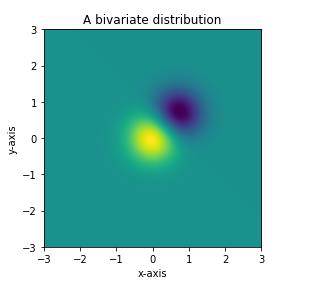
 Data Structure
Data Structure Networking
Networking RDBMS
RDBMS Operating System
Operating System Java
Java MS Excel
MS Excel iOS
iOS HTML
HTML CSS
CSS Android
Android Python
Python C Programming
C Programming C++
C++ C#
C# MongoDB
MongoDB MySQL
MySQL Javascript
Javascript PHP
PHP
- Selected Reading
- UPSC IAS Exams Notes
- Developer's Best Practices
- Questions and Answers
- Effective Resume Writing
- HR Interview Questions
- Computer Glossary
- Who is Who
How can a simple bivariate distribution be shown using ‘imshow’ in Matplotlib Python?
Matplotlib is a popular Python package that is used for data visualization. Visualizing data is a key step since it helps understand what is going on in the data without actually looking at the numbers and performing complicated computations.
It helps in communicating the quantitative insights to the audience effectively. Matplotlib is used to create 2 dimensional plots with the data. It comes with an object oriented API that helps in embedding the plots in Python applications. Matplotlib can be used with IPython shells, Jupyter notebook, Spyder IDE and so on.
It is written in Python. It is created using Numpy, which is the Numerical Python package in Python.
Python can be installed on Windows using the below command −
pip install matplotlib
The dependencies of Matplotlib are −
Python ( greater than or equal to version 3.4) NumPy Setuptools Pyparsing Libpng Pytz Free type Six Cycler Dateutil
Bivariate distribution is the probability that a certain event would occur when two independent random variables are present.
The ‘imshow’ function is generally used to display images as well as plots in Matplotlib.
Let us understand how Matplotlib can be used to plot a bivariate distribution −
Example
import numpy as np
import matplotlib.cm as cm
import matplotlib.pyplot as plt
import matplotlib.cbook as cbook
from matplotlib.path import Path
from matplotlib.patches import PathPatch
np.random.seed(9654241)
delta = 0.025
x = y = np.arange(−4.5, 4.5, delta)
X, Y = np.meshgrid(x, y)
Z1 = np.exp(−X**2 − Y**2)
Z2 = np.exp(−(X − 1)**2 − (Y − 1)**2)
Z = (Z1 − Z2) * 2
fig, ax = plt.subplots()
plt.title('A bivariate distribution')
plt.xlabel('x−axis')
plt.ylabel('y−axis')
im = ax.imshow(Z, interpolation='bilinear',
origin='lower', extent=[−3, 3, −3, 3],
vmax=abs(Z).max(), vmin=−abs(Z).max())
plt.show()
Output

Explanation
The required packages are imported and its alias is defined for ease of use.
The data is created using the ‘random’ library’s ‘seed’ function.
The data is created using the ‘Numpy’ library for two different data sets.
An empty figure is created using the ‘figure’ function.
The ‘subplot’ function is used to create 2 separate plots within the same plot.
The data is plotted using the ‘plot’ function.
The set_xlabel, set_ylabel and set_title functions are used to provide labels for ‘X’ axis, ‘Y’ axis and title.
The figure is assigned to a variable using ‘imshow’ function.
It is shown on the console using the ‘show’ function.

